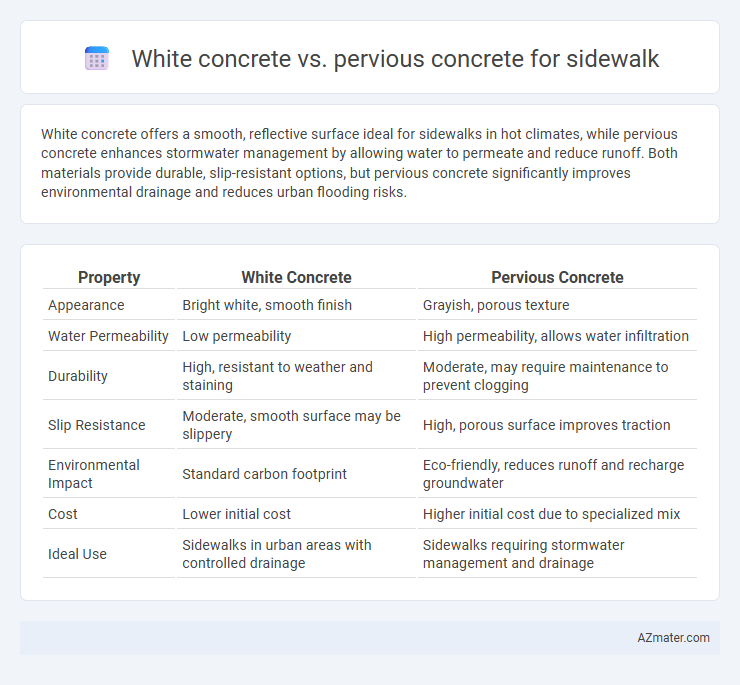White concrete offers a smooth, reflective surface ideal for sidewalks in hot climates, while pervious concrete enhances stormwater management by allowing water to permeate and reduce runoff. Both materials provide durable, slip-resistant options, but pervious concrete significantly improves environmental drainage and reduces urban flooding risks.
Table of Comparison
| Property | White Concrete | Pervious Concrete |
|---|---|---|
| Appearance | Bright white, smooth finish | Grayish, porous texture |
| Water Permeability | Low permeability | High permeability, allows water infiltration |
| Durability | High, resistant to weather and staining | Moderate, may require maintenance to prevent clogging |
| Slip Resistance | Moderate, smooth surface may be slippery | High, porous surface improves traction |
| Environmental Impact | Standard carbon footprint | Eco-friendly, reduces runoff and recharge groundwater |
| Cost | Lower initial cost | Higher initial cost due to specialized mix |
| Ideal Use | Sidewalks in urban areas with controlled drainage | Sidewalks requiring stormwater management and drainage |
Introduction: Understanding White Concrete and Pervious Concrete
White concrete offers a clean, reflective surface ideal for enhancing visibility and reducing urban heat on sidewalks, made primarily with white Portland cement and light-colored aggregates. Pervious concrete features a porous structure that allows water to infiltrate the pavement, effectively reducing stormwater runoff and improving ground recharge. Both materials present unique benefits for sidewalks, targeting aesthetics and environmental sustainability respectively.
Composition and Material Differences
White concrete primarily consists of white Portland cement, aggregates like quartz or marble chips, and minimal iron content to maintain its bright appearance, while pervious concrete features a mixture of cement, coarse aggregates, and little to no fine aggregates, allowing water to permeate through its porous structure. The composition of white concrete targets aesthetics and durability with a dense, smooth finish, whereas pervious concrete prioritizes environmental benefits and stormwater management through its high void content. Material differences in cement type, aggregate size, and porosity directly impact their function, making white concrete suitable for visually appealing sidewalks and pervious concrete ideal for sustainable, permeable pavement solutions.
Aesthetic Appeal: Visual Comparison
White concrete offers a clean, bright surface that enhances sidewalk visibility and provides a modern, polished look suitable for urban settings. Pervious concrete, with its porous texture and natural gray tone, creates a more rustic and organic aesthetic that blends well with green spaces and environmentally focused designs. The choice between them depends on desired visual impact; white concrete emphasizes sleek, crisp lines, while pervious concrete highlights a textured, eco-friendly appearance.
Structural Strength and Durability
White concrete offers high compressive strength and excellent durability, making it ideal for sidewalks subject to heavy pedestrian and light vehicular traffic. Pervious concrete provides adequate structural strength while promoting water drainage, reducing surface runoff and minimizing freeze-thaw damage. However, pervious concrete generally has lower durability under heavy loads and requires regular maintenance to maintain its porosity and structural integrity.
Permeability and Water Management
Pervious concrete offers superior permeability compared to white concrete, allowing water to pass through its porous structure and reducing surface runoff. This enhanced water management capability helps in replenishing groundwater and prevents puddling on sidewalks. White concrete, while aesthetically pleasing, has a dense composition that limits water infiltration, making it less effective for sustainable drainage solutions.
Environmental Impact and Sustainability
White concrete reduces urban heat island effect due to its high reflectivity, lowering cooling energy consumption and mitigating temperature rise in sidewalk areas. Pervious concrete enhances stormwater management by allowing rainwater to permeate, reducing runoff and promoting groundwater recharge, which supports sustainable urban drainage systems. Both materials contribute to environmental sustainability, with white concrete optimizing thermal comfort and pervious concrete improving water quality and resilience against flooding.
Installation Process and Time Required
White concrete installation for sidewalks involves standard mixing, pouring, finishing, and curing procedures, typically taking 24 to 48 hours to set adequately before use. Pervious concrete requires careful placement to maintain its porous structure, with a faster setting time of about 24 hours, but demands meticulous handling to avoid clogging during installation. Both materials necessitate skilled labor, but pervious concrete installation includes extra steps such as ensuring proper compaction and drainage, which may extend overall project timing despite quicker curing.
Maintenance Requirements and Longevity
White concrete sidewalks require regular sealing and cleaning to prevent staining and surface wear, maintaining their bright appearance over time. Pervious concrete offers enhanced durability with lower maintenance needs, as its porous structure reduces water pooling and prevents freeze-thaw damage, extending sidewalk lifespan. Long-term, pervious concrete demonstrates superior resistance to cracking and surface degradation compared to white concrete, making it a cost-effective choice for sustainable sidewalk infrastructure.
Cost Analysis: Initial and Long-Term Expenses
White concrete generally incurs higher initial costs due to the use of white cement and additional pigments, while pervious concrete may have moderate upfront expenses related to specialized aggregates and installation techniques. Over the long term, pervious concrete tends to reduce maintenance and stormwater management expenses by allowing water infiltration, potentially lowering runoff control costs. White concrete sidewalks might require more frequent cleaning and sealing to maintain aesthetic appeal, increasing ongoing maintenance expenses compared to the more functional, low-maintenance pervious concrete surfaces.
Best Application Scenarios for Sidewalks
White concrete is ideal for sidewalks in urban areas requiring high reflectivity to reduce heat absorption and enhance nighttime visibility, improving pedestrian safety. Pervious concrete suits sidewalks in residential or park settings where stormwater management is critical, allowing water to infiltrate and reduce runoff. In environments with frequent rainfall or strict environmental regulations, pervious concrete prevents water pooling, while white concrete is preferred in hot climates to mitigate heat island effects.

Infographic: White concrete vs Pervious concrete for Sidewalk
 azmater.com
azmater.com